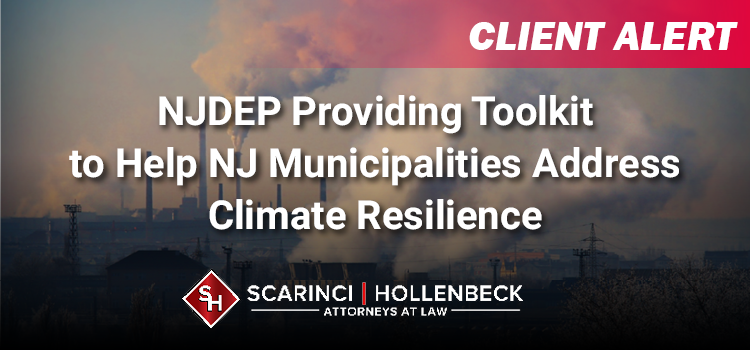
The New Jersey Department of Environmental Protection (NJDEP) recently released the Resilient NJ: Local Planning for Climate Change Toolkit...
The New Jersey Department of Environmental Protection (NJDEP) recently released the Resilient NJ: Local Planning for Climate Change Toolkit. It is designed to help municipal and county governments address climate change through sustainable land use planning.
“Decisions by local governments and regional planning agencies about zoning, redevelopment, housing, open space, and capital investment will have dramatic implications for the vulnerability of the natural and built environments,” Commissioner Shawn LaTourette said in a press statement. “Integrating climate change into these decisions and all planning efforts will ensure investments anticipate the conditions of tomorrow, making it easier to adapt as the climate continues to change and sea level continues to rise.”
Amendments to MLUL to Reflect Climate Change
The toolkit follows amendments to the Municipal Land Use Law (MLUL) that Gov. Phil Murphy signed into law in February. The MLUL now requires municipalities to incorporate a climate-change-related hazard vulnerability assessment into any Master Plan Land Use Element adopted after signing. The new requirement applies to any land use plan element amended or adopted after February 4, 2021, the date the bill was enacted into law.
Under the MLUL amendments, the climate change-related hazard vulnerability assessment must:
- Analyze current and future threats to, and vulnerabilities of, the municipality associated with climate change-related natural hazards;
- Include a build-out analysis of future residential, commercial, industrial, and other development in the municipality, and an assessment of the threats and vulnerabilities identified above related to that development;
- Identify critical facilities, utilities, roadways, and other infrastructure that is necessary for evacuation purposes and for sustaining quality of life during a natural disaster, to be maintained at all times in an operational state;
- Analyze the potential impact of natural hazards on relevant components and elements of the master plan;
- Provide strategies and design standards that may be implemented to reduce or avoid risks associated with natural hazards;
- Include a specific policy statement on the consistency, coordination, and integration of the climate-change related hazard vulnerability assessment with certain other plans adopted by the municipality; and
- Rely on the most recent natural hazard projections and best available science provided by the NJDEP.
The new law also requires the NJDEP, upon request by a planning board, to provide technical assistance, as practicable, to a municipality preparing a climate change-related hazard vulnerability assessment. However, groups such as the New Jersey State League of Municipalities have raised concerns about how local governments will pay for the new plans. Assessing vulnerability to the effects of climate change is now required for new master plans by a change in the state’s Municipal Land Use Law, signed by Murphy in February. The law also directs municipalities to examine the vulnerability of future development, and to include ways of mitigating natural hazards caused by climate change.
Climate Change Toolkit
When it comes to protecting New Jersey from climate change, officials have acknowledged that much of the burden will fall on local communities. The State’s chief resilience officer Dave Rosenblatt maintains that one of the best ways to address the risks of flooding and other risks is through local planning. The ‘toolkit’ allows for the integration of land-use law to strengthen against storms, flooding, and other risks. It also designed to assist municipalities in building planning teams, engaging the public, and developing a strategy to track their progress towards resiliency.
According to the NJDEP, the intended outcome of the tool kit is the creation of local strategies with specific resilience actions tailored to each community’s needs. Strategies may include enhanced building and construction standards; retrofitting, elevating, or replacing existing structures and infrastructure; construction of more resilient structures and infrastructure; and many other potential actions. Municipalities that utilize the new toolkit can also meet their obligations for the new MLUL requirements and climate resilience-related Plan Endorsement requirements adopted by the State Planning Commission in October 2020.
The toolkit also includes several potential sources of federal funding, including the Federal Emergency Management Agency, Department of Housing and Urban Development and Department of Transportation, as well as state options such as the Infrastructure Bank, the Economic Development Authority and the NJDEP. At the local level, possible sources of funding include stormwater-utility fees, bonding, and user fees.
If you have questions, please contact us
For more information about the new climate change tool kit or the legal issues involved, we encourage you to contact a member of Scarinci Hollenbeck’s Government Law Group at 201-896-4100.
